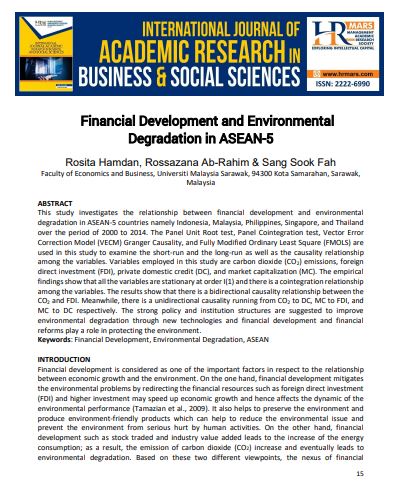
Keyword(s)
Author(s)
Rosita Hamdan (a), Rossazana Ab-Rahim (a), Sang Sook Fah (a)
Country(ies)
Publisher
Published Date
Access
DOI
(a) Faculty of Economics and Business, Universiti Malaysia Sarawak, 94300 Kota Samarahan, Sarawak, Malaysia
This study investigates the relationship between financial development and environmental degradation in ASEAN-5 countries namely Indonesia, Malaysia, Philippines, Singapore, and Thailand over the period of 2000 to 2014. The Panel Unit Root test, Panel Cointegration test, Vector Error Correction Model (VECM) Granger Causality, and Fully Modified Ordinary Least Square (FMOLS) are used in this study to examine the short-run and the long-run as well as the causality relationship among the variables. Variables employed in this study are carbon dioxide (CO2) emissions, foreign direct investment (FDI), private domestic credit (DC), and market capitalization (MC). The empirical findings show that all the variables are stationary at order I(1) and there is a cointegration relationship among the variables. The results show that there is a bidirectional causality relationship between the CO2 and FDI. Meanwhile, there is a unidirectional causality running from CO2 to DC, MC to FDI, and MC to DC respectively. The strong policy and institution structures are suggested to improve environmental degradation through new technologies and financial development and financial reforms play a role in protecting the environment.
Cite
Hamdan, R., Ab-Rahim, R., & Fah, S. S. (2018). Financial Development and Environmental Degradation in ASEAN-5. International Journal of Academic Research in Business and Social Sciences, 8(12), 14–32.